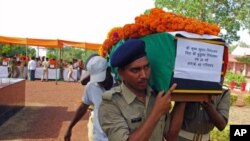In India, suspected Maoists have killed nine policemen. This is the second attack this month by the rebels, who are considered the country’s biggest internal security threat.
Policemen combed jungles along the border of Orissa and Chattisgarh states in the east for suspected rebels who ambushed a police patrol a day earlier.
Police chief of Chattisgarh’s capital Raipur, Mukesh Gupta, told VOA that the policemen had gone to “verify some information” when their vehicle broke down. He said they were returning in a tractor when the rebels, who outnumbered them, opened fire.
“It was simple ambush," said Gupta. "There was an exchange of fire on both sides, and ultimately because they (rebels) were too much in number and they had their important positions with them, so our men were lost.”
The attack comes three weeks after 11 policemen were killed in the neighboring Jharkhand state. In that ambush, the rebels used a popular tactic - lure police personnel to a remote area with rumors that they plan to hold a meeting and then mount an attack from strategic positions.
The two attacks follow a relative lull in Maoist violence, which escalated sharply last year. Officials say 1,169 people were killed in rebel-related violence in 2010. The toll was the highest since the rebels launched their so-called “people’s war” four decades ago. The conflict has claimed about 250 lives so far this year.
Ajai Sahni, who heads the Institute of Conflict Management in New Delhi, said the Maoists appear to be entrenching themselves in areas where their influence runs deep.
“The intensity in the areas of influence or in the core areas has certainly escalated," said Sahni. "There seems to be an effort to consolidate at a deeper level in the areas of activity rather than spread themselves thin.”
The Maoists are active along a wide belt in eastern and central India, a mineral rich, but underdeveloped area which remains virtually untouched by the economic boom that has increased prosperity in other parts of the country.
The government has vowed to defeat the rebels, and police in affected states are undergoing training and getting new weaponry.
Sahni says government forces, however, still do not have the preparedness to take on the rebels.
“A lot of people have been recruited, but if you actually look at deployments in counter insurgency, there has not been a very, very significant increase of capacity," said Sahni. "The point is not how seriously you take a threat, the point is how effectively you are able to respond. As far as that is concerned, our patterns of response remain dominated by bureaucracies”
Experts say the Maoists are winning more recruits among landless laborers and tribal minorities on whose behalf they say they are fighting.
Attack by Suspected Rebels Kills Nine Policemen in India









